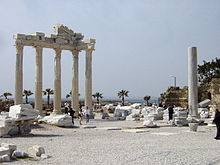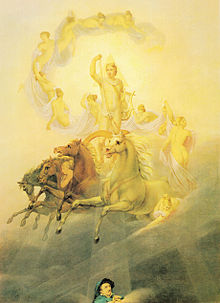Apollo

Apollo ( ancient Greek Ἀπόλλων , Latin Apollo , German also Apollo ) is in Greek and Roman mythology the god of light, healing, spring , moral purity and moderation as well as prophecy and the arts , especially music , poetry and the Singing ; he is also the god of healing and archers. As the son of the father of gods Zeus and the goddess Leto (Latin Latona ) conceived in Didyma in Asia Minor , he belonged, like his first-born twin sister Artemis (Latin Diana ), to the Olympic gods , the twelve main gods of the Greek pantheon . The sanctuary in Delphi , the most important oracle site of antiquity , was dedicated to him.
Origin and name
The origin of the Apollo cult is believed to be in Asia Minor. The etymology of the name Apollon is unclear. Possibly it meant in Greek “herald”, “destroyer” or “destroyer” or “disaster repeller”. In the Iliad , Homer also called him Smintheus (that is, "the rat eater") and "the one who met from afar". As Phoibos Apollon ("the shining one", Latinized: Phoebus ) he was also equated with the sun god Helios . Other names were Boëdromios , "the one who rushes to help with a battle cry," and Loxias .
Pythagoreans and Platonists , who particularly venerated Apollo, were convinced that his name had a philosophical meaning. They interpreted it as A-pollon (“not many”), composed of a- (“not”, alpha privativum ) and pollón (“a lot”). In this they saw an allusion to the one , the highest, absolutely transcendent principle, the opposite of plurality. According to this interpretation, which the Neo-Platonist Plotinus ascribes to the Pythagoreans, “Apollon” is the god's name of the One. This etymology of the name Apollo is not expressly attested in Plato's works , but he seems to have known it. In research it is assumed that it was part of his “ unwritten teaching ”, which was only conveyed orally .
myth
Attributions
As the protector of the arts and music, Apollon presided over the nine muses (epithet Musagetes) and was at the same time a god of atonement. He was also regarded as Apollon Epicurios , the god of healing and as such saved the inhabitants of Figalia from a plague epidemic. But it also played a role in other areas of life: it brought disease, death and annihilation (like the Babylonian god Nergal ) and sent the plague into the Greek camp in the Trojan War . At the same time he brought about rescue from danger (e.g. in the function of Apollon Smintheus , the “destroyer of mice” or Apollon Lyceius as protector of the herds from the wolves). As the god of healing, prophecy and the oracle sites were associated with him. Through the death of Python , Apollon acquired his visionary abilities and was also called Apollon Pythios , in his honor the Pythian Games were celebrated.
He could bestow the gift of prophecy on mortals such as Cassandra , Priam's daughter . In the Trojan War he was on the side of the Trojans and intervened in the battles with targeted bow shots; as an avenger he sent the plague with his arrows into the camp of the Greeks, because they had captured and enslaved the daughter of a priest of Apollo.
Apart from reports that are typical for the character, such as the musical competition with the shepherd god Pan , Apollo appears in a conspicuously large number of stories told by him as avenger or killer. So he killed the Niobids and the giant Tityos , who wanted to rape his mother; he killed (and skinned) the satyr Marsyas , because he was said to make more beautiful music than the god. He ordered Orestes to kill his own mother Clytaimnestra to avenge the murder of his father Agamemnon . The Erinyes , who did not tolerate this, then beat Orestes madly, but Apollo successfully defended him against them and Clytaimnestra's ghost before the Areopagus in Athens.
stories
The first act of Apollon, who was born in Lycia or on the “floating island” Delos , was the killing of the snake Python, the enemy of his mother Leto . Apollon hit Python with an arrow. Python fled seriously injured to the oracle of mother earth in Delphi , who was named in honor of Delphyne, the Python's wife. Apollo followed Python into the shrine and killed him next to the sacred crevice. Since this serpent, which possessed extraordinary prophetic powers, was a child of the Gaia , he had to go to Tarrha in Crete for atonement and there subject a purification ceremony.
Once Apollo even dared to rebel against his father Zeus : When this Apollo's son Asclepius had killed, Apollo took revenge by murdering the Cyclops . As a punishment for this act, he had to work in the sheepfold of King Admetus of Pherai or tend his cows. Since he had approached Admetus as a stranger and had been welcomed in a friendly manner, he made sure that his animals gave birth to twins and helped him to win Alcestis , the daughter of Pelias . In addition, he helped him against Thanatos (death) when he was about to die.
At the onset of winter, Apollon flew to the "land of the Hyperboreans " in a wagon pulled by swans . H. the land beyond the north wind.
As a representative of high musical culture, Apollon appears in the music competition with Pan .
Beloved and offspring


The female lovers of Apollo and his descendants with them, as well as his male lovers or favorites were different sources, among others:
- Krëusa
- Akantha
- Rhoio
- Cyrene
- Coronis
- Chione
- Daphne
- Dryope
- Hyakinthos
- Calliope
- Kassandra
- Kyparissus
- Leukothea
- Manto
- Urania
- Thalia
swell
- Aelian , Varia Historia
- Libraries of Apollodorus , 1st and 3rd book
- Diodorus Siculus , III. book
- Homeric hymn to Apollo
- Homer , Iliad
- Hyginus Mythographus , Fabulae
temple
Numerous temples were dedicated to Apollo (see list under Temple of Apollo ). These include the oracle sanctuaries in Delphi and Abai .
Aftermath
Since Apollon was assigned to the arts, he has appeared again and again in poetry and the visual arts since ancient times. An example from 1914 is Giorgio de Chirico's painting The Song of Love ( Le chant d'amour ). It shows the mysterious combination of an Apollo bust attached to a house wall and a rubber glove. A train steams in the background.
Friedrich Nietzsche popularized the pair of terms Apollonian-Dionysian to describe opposing human traits.
The Apollo Peak in Antarctica and the asteroid (1862) Apollo are named after him.
See also
- Apollon Sauroktonos
- Apollonius
- Grannus (to Apollo Grannus)
literature
Overview representations
- Fritz Graf : Apollo . In: Encyclopedia of Religion , Vol. 1, 2005, pp. 424-426
- Ulrich van Loyen, Silke Walther: Apollon. In: Maria Moog-Grünewald (Ed.): Mythenrezeption. The ancient mythology in literature, music and art from the beginnings to the present (= Der Neue Pauly . Supplements. Volume 5). Metzler, Stuttgart / Weimar 2008, ISBN 978-3-476-02032-1 , pp. 115-131.
Compilation of the iconographic sources
- Vassilis Lambrinoudakis : Apollon . In: Lexicon Iconographicum Mythologiae Classicae (LIMC). Volume II, Zurich / Munich 1984, pp. 183–327.
- Erika Simon , Gerhard Bauchhenß : Apollo . In: Lexicon Iconographicum Mythologiae Classicae (LIMC). Volume II, Zurich / Munich 1984, pp. 363-464.
Collections of articles
- Lucia Athanassaki et al. (Ed.): Apolline Politics and Poetics. The European Cultural Center of Delphi, Athens 2009, ISBN 978-960-88520-4-4
- Jon Solomon (Ed.): Apollo. Origins and Influences . University of Arizona Press, Tucson 1994.
Investigations
- Walter Burkert : Apellai and Apollon . In: Rheinisches Museum . Vol. 118, 1975, pp. 1-21.
- Franz Dirlmeier : Apollon. God and educator of the Hellenic nobility. 1939.
- Georges Dumézil : Apollo Medicus . In: In Apollon sonore et autres essais. Vingt-cinq esquisses de mythologie . Paris 1982, pp. 36-42.
- Martin Flashar : Apollon Kitharodos . Böhlau, Cologne 1992.
- Joseph Eddy Fontenrose : The Delphic Oracle. Its responses and operations . Berkeley 1978.
- Joseph Eddy Fontenrose: Didyma. Apollo's Oracle, Cult, and Companions . Berkeley 1998.
- Jean Gagé: Apollon Romain. Essai sur le culte d'Apollon et le développement du “ritus graecus” à Rome des origines à Auguste . Paris 1955.
- Fritz Graf: Apollo . Routledge, London and New York 2009, ISBN 0-415-31711-8 .
- Herbert Hoffmann: Divergent Archeology . Mainz and Ruhpolding 2007, pp. 207–221.
- Michael Pettersson: Cults of Apollo at Sparta. The Hyakinthia, the Gymnopaidia and the Karneia . Stockholm 1992.
- Harvey A. Shapiro: Art and Cult under the Tyrants in Athens . Zabern, Mainz 1989, pp. 48-63.
- Froma I. Zeitlin: Apollo and Dionysus: Starting from Birth . In: Manfred Horstmanshoff u. a. (Ed.): Kykeon. Studies in Honor of HS Versnel . Brill, Leiden 2002, pp. 193-218.
Medieval and modern reception
- Jane Davidson Reid: The Oxford Guide to Classical Mythology in the Arts, 1300-1990s , Volume 1. Oxford University Press, New York / Oxford 1993, ISBN 0-19-504998-5 , pp. 162-185
Web links
- Works about Apollon in the German Digital Library
- Works about Apollon in the catalog of the German National Library
- private page The Apollonian and the Dionysian: Nietzsche's pair of opposites in ancient myth
- Apollon - God of Light ( Memento from February 5, 2005 in the Internet Archive )
- 1700 photos of representations of Apollo, in the Warburg Institute Iconographic Database
Remarks
- ↑ Christina Schefer: Plato's unspeakable experience , Basel 2001, pp. 128–129; Jens Halfwassen : The ascent on the one hand. Investigations on Plato and Plotinus , 2nd edition, Leipzig 2006, p. 258, note 102; Hans Krämer : Plato's unwritten teaching . In: Theo Kobusch, Burkhard Mojsisch (Ed.): Platon. His dialogues in the view of new research , Darmstadt 1996, pp. 249–275, here: 263; Giovanni Reale: Plato's protological foundation of the cosmos and the ideal polis . In: Enno Rudolph (Ed.): Polis and Kosmos. Natural philosophy and political philosophy in Plato , Darmstadt 1996, pp. 3–25, here: 9–11.
- ^ Ferdinand Peter Moog: Apollon. In: Werner E. Gerabek , Bernhard D. Haage, Gundolf Keil , Wolfgang Wegner (eds.): Enzyklopädie Medizingeschichte. De Gruyter, Berlin / New York 2005, ISBN 3-11-015714-4 , p. 75 f.
- ↑ The Temple of Apollon Epicurios ( Memento of March 4, 2016 in the Internet Archive )
- ↑ Homer , Iliad 1,44–53 ( Memento of November 1, 2016 in the Internet Archive ).
- ^ The Song of Love , moma.org, accessed May 1, 2012
- ↑ Barbara von Reibnitz : Apollinian – Dionysian . In: Basic aesthetic terms . Vol. 1, Stuttgart 2000, pp. 246-271.



